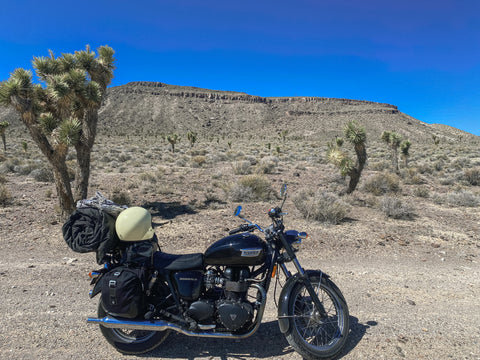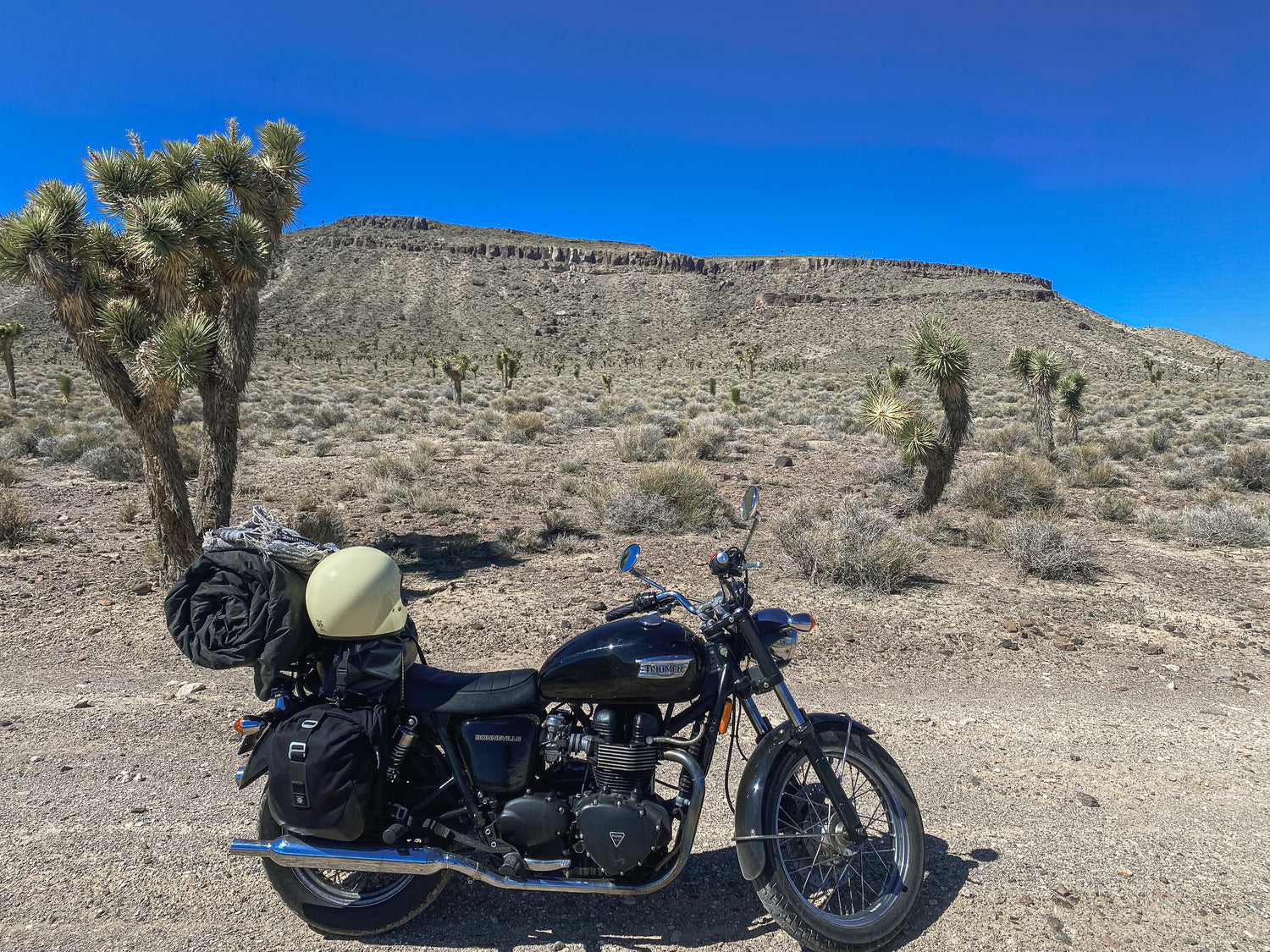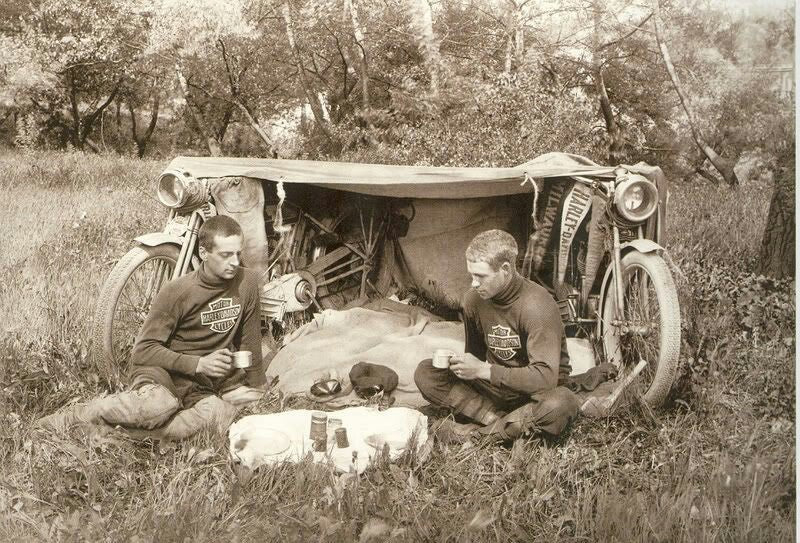Five Lessons I've Learned Motorcycle Camping Around the World

Riding street and going camping off your bike are two very different experiences. Here are five lessons I’ve learned moto camping over the years.
By Owen Clarke
In the last few years, I’ve done quite a bit of motorcycle camping in quite a few countries around the world. I’ve been an outdoorsman all my life and ridden motorcycles for a while as well, but I’ve found that combining camping and motorcycles is unique.
Riding a bike out to a remote campsite is a very different experience than cruising on the street, and camping with your bike is a very different experience than camping out of a car, or even backpacking. You have to take different factors into consideration.
I’ve made my fair share of mistakes along the way—and some of ‘em have put me in a few dicey situations, as you’ll see below. So, here are five lessons I’ve learned. Hopefully, you won’t make the same mistakes.

Don’t Bring a Bike You Can’t Lift
Some folks will debate me on this, and to be clear, I’m not saying skinny little girls can’t ride big Harleys on the street. Street is one thing. But if you’re out motorcycle camping by yourself—you damn sure have to be able to lift your ride. No one is coming to give you a hand.
While investigating a controversial open-pit mine in the Peruvian Cordillera Blanca last fall for a magazine article, I was chased out by a truckload of guards. I dusted them on the CB500X I was riding, but a few klicks down the gnarly dirt road leading out of the mine, I came around a switchback and lowsided. The bike slid up the high angle of the muddy slope to my left and came back down on top of me, pinning my right thigh to the ground.
In that position, with the bike sitting higher than me on the slope, it was impossible for me to lift it off myself. It was like attempting a 400-pound bench press. So I squirmed like a roach under a boot for almost ten minutes, waiting for the guards to arrive, before realizing I could reach around the tank and unlace my boot from the other side, then nudge the bike up a quarter-inch and slide my leg out.
Once I was out from under the bike I was easily able to lift it. The guards never caught up, and I made it back to the village below without any issues save a dinged exhaust and tweaked handlebars. But I came home from Peru a month later with the realization I really needed to start hitting the gym.
The Moral: If you’re taking a motorcycle camping, make sure you can lift it, at the bare minimum, from a standing position on flat ground. If you’re going off-road or into a more remote destination, I’d strongly advise taking a bike that you can manhandle pretty easily. Maybe you won’t be chased by machine gun-toting Peruvian mine guards, but you’ll still be in trouble if you’re stranded with a downed bike.
If you want to check out the article that came out of that trip, it’s in the latest print issue of Climbing magazine and published digitally HERE.
Protect Your Face & Eyes
Riding through a wheat field on the Albanian coast with my girlfriend a month ago, I felt like I was in heaven. The sun was mellow and warm, perched high in the sky, the Adriatic Sea was sparkling like crystal to my left, and the whole world just seemed peach perfect…
Then a plum-sized wasp rocketed into the crack between my temple and my helmet. Jammed in there, the sucker stung me four or five times before I could wiggle my finger in and smush him. All told it was no biggie, I just spent the rest of the day with a face so swollen I looked like the dude from Hey Arnold! But if that wasp had flown in an inch to the left and hit my eye—it would’ve been game over for that eyeball.
Hopefully big black Albanian wasps aren’t on the horizon for you, but rocks, dirt, woodchips, and other debris are definitely going to be flying your way while riding the backroads to your next campsite. A single well-aimed bit of roadside crap can take out an eye, even at low speeds.
The Moral: Shades might look cooler, but if you’re riding to camp in real off-grid terrain (or an Albanian wheatfield), consider a visor or at least goggles to keep your eyes safe.

Fill Up Early and Often
There’s no sense in gunning it to the last minute. I’ve been living in Las Vegas, riding and camping in the desert a lot recently, and there are stretches of Nevada highway where you won’t find a gas station—or anything at all, really—for over 50 miles. These last few trips have highlighted the importance of making sure I fuel up early and often.
Even if you aren’t in the wastelands of Nevada, when you’re camping off your bike you need a bit more wiggle room on fuel than usual. Oftentimes you’ll ride a rough backroad for 10 to 15 miles before getting to your campsite. When you double that for a trip both ways and factor in dogshite fuel efficiency because you’ll be riding in second gear most of the way, carrying loads of gear & supplies, plus a bit of fuel for taking wrong turns, playing around, and firing up your ride each morning to keep the battery charged…
Well, you start to see you’ll need a considerable chunk of gas to get in and out.
The Moral: Don't wait to fill up after you hit rez. Even if it’s only a few miles of dirt road to your campsite, you’ll use more fuel than you think when motorcycle camping.

Always Use a Stand Plate
There’s no story here because I can’t say I’ve ever had a bike fall on top of me in the night. But I honestly might not be here if I had. Bringing (and using) a stand plate is a must when motorcycle camping, especially if you’re camping next to your ride. Even if the ground looks solid when you set up camp, overnight rain can turn hard-packed dirt into soft mud by morning.
There’s not a whole lot to say here, because this is an easy rule to follow (the Nomad 4 actually comes with a stand plate), and the consequences can be serious if you forget to use one. If your bike goes down you might just end up with scuffed paint, a snapped shifter peg, or a bent handlebar, but if you’re sleeping beneath it, you could come away with broken bones or worse.
The Moral: This one’s simple. Don’t become Flat Stanley overnight. Bring and use a stand plate whenever you aren’t parked on asphalt. Any flat, stout material can work as a stand plate, such as a two-by-four or piece of sheet metal.

Carry a Physical Map
Most of us navigate with our smartphones today, or with some other kind of electronic tech. The humble map has gone by the wayside. But when you’re motorcycle camping, it really pays to have a physical map & compass as backup navigational tools.
While trying to ride and hike to the summit of a volcano on the Mexican-Guatemalan border last spring. I took an XR250 up to 11,000 feet in the hills below, stashed it, and followed what looked like a group of hikers a few hundred meters ahead of me, climbing around the western slope of the volcano. They were all carrying oversized blue backpacks and moving pretty fast, but I managed to gain on them slowly.
I wasn’t quite sure where I was or where the trail was, and my phone (which I was using as a GPS) was dead. I didn’t have a paper map with me. But we were in the middle of nowhere, so I assumed that these fellows were on the trail to the summit. What else could they be doing out here?
An hour later, I came around a bend in the trail to find an old bolt-action leveled at my chest. It was in the hands of a sweaty, jittery Guatemalan standing a few paces away. Half a dozen others were all clustered in the trail behind him. They’d been waiting on me. A couple of them had machetes, and the one in front had this decrepit rifle that looked like it’d seen the charge at San Juan Hill.
I put my hands up, but they seemed just as freaked out as I was, so with my mediocre Spanish, I told them I was just looking to climb the mountain. Once they heard that, they relaxed a bit, and it was obvious they’d just been worried that I was following them. The “backpacks” I thought they’d been carrying were actually just large, plastic blue sacks, strung to their shoulders with twine. In any case, whatever they were doing was none of my business. We were only a few miles from the Mexican border—so it may have been less than legal.
With the confusion cleared up, they pointed me in the right direction (I’d hiked three miles the wrong way), and we got on with our days.
The Moral: Know where you’re going and bring hard copies to back up that knowledge. All the high-tech electronics in the world won’t save you if they get wet, busted, or run out of battery. A reliable waterproof, tearproof map is well worth the purchase as a backup navigational tool.
Owen Clarke is an American adventure travel journalist. His writing covers the gamut of outdoor and action sports, but he specializes in mountaineering and motorcycling. He serves as an editor-at-large for Climbing and the executive editor of Skydiving Source and Indoor Skydiving Source. He is also a regular contributor to Iron & Air.





1 comment
Patrick Tuohy
Great advice. Thanks
Great advice. Thanks